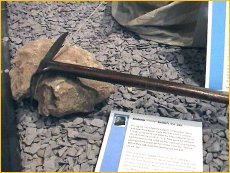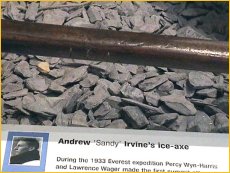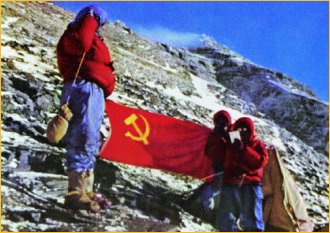
| |||||||
Jochen Hemmleb: First Traces: 1933-1991
May 30, 1933, Everest Northeast Ridge, 27,725 ft.
Percy Wyn-Harris, member of the British Mount Everest-Expedition 1933, discovers an ice-axe:
"[The axe] was lying loose on a slab at an angle of about 30°, about 60 ft. Below the crest of the N.E. arête. The maker was Willisch of Taesch [Switzerland, J.H.]. […] A number of Willisch axes were supplied to the expedition in 1924, so we cannot be certain whether this axe was being used by Mallory or by Irvine." (Ruttledge, H. "The Mount Everest Expedition, 1933, Alpine Journal, 45, 1934, p. 226)
Ruttledge later wrote about the possible meaning of this discovery in his book Everest 1933 (p. 145):
"It seems probable that the axe marked the scene of a fatal accident. [...] Neither climber would be likely to abandon it deliberately on the slabs, and its presence there would seem to indicate either that it was accidentally dropped when a slip occurred or that its owner put it down possibly in order to have both hands free to hold the rope. The slabs at this point are not particularly steep, but they are smooth and in places have a covering of loose pebbles which are an added danger. A slip might easily occur, and would be difficult to stop. [...] Below, the slabs steepen considerably."
Noel Odell disagreed, providing a different explanation ("The ice-axe found on Everest", Alpine Journal, 46, 1934):
"It seems to me very possible that one of them - and more plausibly Irvine, who was less used to carrying an axe on a rock-climb than Mallory - may have decided to leave his axe on the ridge during the ascent, to be picked up on the descent, in view of the climbing being almost entirely on rock under the conditions prevailing at that time; one axe would be retained by the party in case of eventualities, a practice by no means uncommon on Alpine rock-peaks."
In 1963 it was discovered that a triple nick on a military swagger stick, found among Andrew Irvine's possessions, matched a similar mark on the ice-axe's shaft (Odell, N.E. "The ice-axe found on Everest in 1933", Alpine Journal, 68, 1963). It is therefore highly likely that the ice-axe had belonged to Andrew Irvine.
May 5, 1975, Everest North Face, 26,760 ft.:
In 1979, a Chinese climber named Wang Hongbao told Japanese mountaineer Ryoten Hasegawa of a remarkable find he had made on Everest four years earlier:
"Mr Wang told our Japanese member R. Hasegawa that he had seen two corpses when he was a member of the 1975 Chinese Everest expedition. One was near the lateral moraine below Camp III on the East Rongbuk Glacier. This might have been Wilson. The other was at 8100 meters (26,576 feet) on the northeast Ridge. Mr Wang could not speak English, but he repeated the word "English! English!" to Mr. Hasegawa. When he had touched the clothing, it had broken to bits and was blown off by the wind. Then he had put snow on the body and buried it." (Letter by H. Suzuki, Japanese Alpine Club, American Alpine Journal, 22, 1980, p. 658)
The day after his revelation to Hasegawa, Wang and two companions were killed in an avalanche below the North Col.
Hasegawa later recalled Wang had indicated that the mouth of the corpse had been agape, one cheek sunken or pecked by birds. When Hasegawa had written in the snow, "8100 m - dead English body", Wang had given a big nod (quoted in Salkeld, A. People in High Places, p. 130).
Because only two climbers had been missing around that altitude on Everest's North Face prior to 1975, the "English dead" must have been either Mallory or Irvine.
May 15, 1991, Everest Northeast Ridge, 27,800 ft.
"I remembered that I found an oxygen bottle a little ways down the ridge (about 10 minutes below) the First Step. It was definitely old… long and skinny. I left it there. [...] The bottle (maybe two) …was long and skinny (maybe 3-4 inches in diameter and 3 feet long or more) [sic]... not like the 1975 Chinese bottles. Quite rusted, quite old looking." (Eric Simonson, e-mails to the author, March 12,1998)
Eight years later, on May 17, 1999, American Tap Richards recovered the bottle from the Northeast Ridge.
The oxygen cylinder is 1 ft. 11 inches long and 4 inches in diameter, weighing 6.5 lbs. The bottle is undamaged, the rusty steel cylinder bearing remnants of a paint mark: "9", the individual number of the bottle, and the weight units "lbs" and "oz". A stamp on the valve also indicates the cylinder's number, 9. Comparisons with pictures and documents of the Royal Geographical Society, London, prove that the bottle stemmed from the 1924 British Everest expedition. Only one party in 1924 had been using oxygen and could have passed the spot where the bottle was found, so it must have belonged to Mallory and Irvine.

Tap Richards and Eric Simonson with oxygen bottle No. 9 from Mallory and Irvine
© Archive J. Hemmleb, Idstein/Germany
| Proud Climbing Team of the Mallory & Irvine Research Expeditions: | ||




